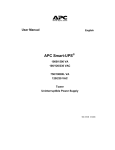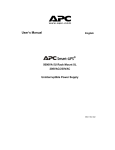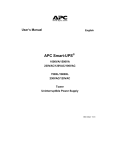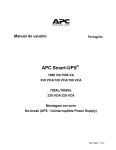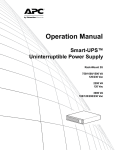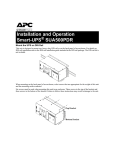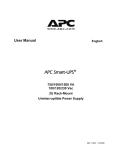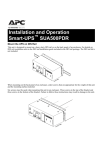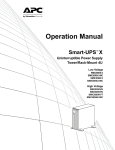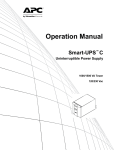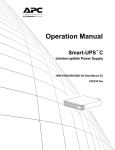Download APC SUA1000-BR uninterruptible power supply (UPS)
Transcript
Installation and Operation Smart-UPS® SUA1000-BR/SUA1500-BR 120 VAC English This manual and the safety guide are available in English on the enclosed CD and the APC Web site, www.apc.com. Este manual e o guia de segurança estão disponíveis em português no CD incluso e no website da APC, www.apc.com. Introduction The APC® by Schneider Electric Smart-UPS® is a high performance uninterruptible power supply (UPS). It provides protection for electronic equipment from utility power blackouts, brownouts, sags, and surges; small utility fluctuations and large disturbances. The UPS also provides battery backup power until utility power returns to safe levels or the batteries are fully discharged. 1: INSTALLATION Read the Safety Instruction sheet before installing the UPS. Unpacking Inspect the UPS upon receipt. APC designed robust packaging for your product. However, accidents and damage may occur during shipment. Notify the carrier and dealer if there is damage. The packaging is recyclable; save it for reuse or dispose of it properly. Check the package contents. The package contains the UPS, a literature kit containing one CD, one serial cable, one USB cable, product documentation and Safety Information. The UPS is shipped with the battery disconnected. Positioning the UPS The UPS is heavy. Select a location sturdy enough to handle the weight. Do not operate the UPS where there is excessive dust or the temperature and humidity are outside the specified limits. PLACEMENT 0º- 40ºC (32º-104ºF) 0-95% Relative Humidity 2.5cm (1in) 1 Connecting Equipment and Power to the UPS SMART-UPS REAR PANEL Y X 1. Plug in the battery connectorn. 2. Connect equipment to the UPS. Note: Do not connect a laser printer to the UPS. A laser printer draws significantly more power than other types of equipment and may overload the UPS. 3. Add any optional accessories to the SmartSlotY. 4. Using the power cord, plug the UPS into a two-pole, three-wire, grounded receptacle only. Avoid using extension cords. 5. Turn on all connected equipment. To use the UPS as a master ON/OFF switch, be sure all connected equipment is switched ON. The equipment will not be powered until the UPS is turned on. 6. To power up the UPS press the 7. button on the front panel. • The UPS charges its battery when it is connected to utility power. The battery charges to 90% capacity during the first three hours of normal operation. Do not expect full battery run capability during this initial charge period. • Check the site wiring fault LED located on the rear panel. It lights up if the UPS is plugged into an improperly wired utility power outlet. Refer to Troubleshooting in this manual. ® For additional computer system security, install PowerChutePlus UPS Power Management and Diagnostic Software. 2 BASIC CONNECTORS Serial Port USB Port Power management software and interface kits can be used with the UPS. Use only interface kits supplied or approved by APC. Use the APC supplied cable to connect to the Serial Port. DO NOT use a standard serial interface cable since it is incompatible with the UPS connector. Both Serial and USB Ports are provided. They cannot be used simultaneously. TVSS Screw The UPS features a transient voltage surge-suppression (TVSS) screw for connecting the ground lead on surge suppression devices such as telephone and network line protectors. When connecting grounding cable, disconnect the unit from the utility power outlet. 2: OPERATION SMART-UPS FRONT PANEL Power On Power Off Online The online LED illuminates when the UPS is supplying utility power to the connected equipment. If the LED is not lit, the UPS is either not turned ON, or is supplying battery power. AVR Trim This LED illuminates to indicate the UPS is compensating for a high utility voltage. AVR Boost This LED illuminates to indicate the UPS is compensating for a low utility voltage. 3 On Battery When the on battery power LED is lit the UPS is supplying battery power to the connected equipment. When on battery, the UPS sounds an alarm—four beeps every 30 seconds. Overload The LED illuminates and the UPS emits a sustained alarm tone when an overload condition occurs. Replace Battery Failure of a battery self-test causes the UPS to emit short beeps for one minute and the replace battery LED illuminates. Refer to Troubleshooting in this manual. Battery Disconnected The replace battery LED flashes and short beep is emitted every two seconds to indicate the battery is disconnected. Automatic Self-Test The UPS performs a self-test automatically when turned on, and every two weeks thereafter (by default). During the self-test, the UPS briefly operates the connected equipment on battery. lights and If the UPS fails the self-test, the replace battery LED immediately returns to online operation. The connected equipment is not affected by a failed test. Recharge the battery for 24 hours and perform another self-test. If it fails, the battery must be replaced. Manual Self-Test Press and hold the self-test. button for a few seconds to initiate the On Battery Operation The Smart-UPS switches to battery operation automatically if the utility power fails. While running on battery, an alarm beeps four times every 30 seconds. button (front panel) to silence the UPS alarm (for the current alarm only. If the utility Press the power does not return, the UPS continues to supply power to the connected equipment until the battery is exhausted. If PowerChute is not being used you must manually save your files and power down before the UPS turns off. DETERMINING ON BATTERY RUN TIME UPS battery life differs based on usage and environment. It is recommended that the battery/batteries be changed once every three years. See the APC Web site, www.apc.com, for on battery run times. 4 3: USER CONFIGURABLE ITEMS NOTE: SETTINGS ARE MADE THROUGH SUPPLIED POWERCHUTE SOFTWARE OR OPTIONAL SMART SLOT ACCESSORY CARDS. FUNCTION FACTORY DEFAULT USER SELECTABLE CHOICES DESCRIPTION Automatic Self-Test Every 14 days (336 hours) Every 7 days (168 hours), On Startup Only, No SelfTest This function sets the interval at which the UPS will execute a self-test. Refer to your software manual for details. UPS ID UPS_IDEN Up to eight characters to define the UPS Use this field to uniquely identify the UPS, (ie. server name or location) for network management purposes. Date of Last Battery Replacement Manufacture Date Date of Battery Replacement Reset this date when you replace the battery module. Minimum Capacity Before Return from Shutdown 0 percent 0, 15, 30, 45, 50, 60, 75, 90 percent The UPS will charge its batteries to the specified percentage before return from a shutdown. Brightly lit: UPS is set to high sensitivity (default). To change the UPS sensitivity, press the voltage (rear sensitivity button panel). Use a pointed object (such as a pen) to do so. Voltage Sensitivity The UPS detects and reacts to line voltage distortions by transferring to battery operation to protect the connected equipment. Where power quality is poor, the UPS may frequently transfer to battery operation. If the connected equipment can operate normally under such conditions, reduce the sensitivity setting to conserve battery capacity and service life. Alarm Control mm/dd/yy Dimly lit: UPS is set to medium sensitivity. Off: Low battery warning interval is about eight minutes. Enable Enable, Mute, Disable 5 You can change the sensitivity level through PowerChute software. User can mute an ongoing alarm or disable all existing alarms permanently. NOTE: SETTINGS ARE MADE THROUGH SUPPLIED POWERCHUTE SOFTWARE OR OPTIONAL SMART SLOT ACCESSORY CARDS. FUNCTION Shutdown Delay FACTORY DEFAULT 90 seconds Low Battery Warning. PowerChute interface software provides automatic, unattended shutdown when approximately two minutes (by default) of battery operated run time remains. USER SELECTABLE CHOICES DESCRIPTION 0, 90, 180, 270, 360, 450, 540, 630 seconds Sets the interval between the time when the UPS receives a shutdown command and actual shutdown. Brightly lit: Low battery warning interval is about two minutes. Dimly lit: Low battery warning interval is about five minutes. Off: Low battery warning interval is about eight minutes. The low battery warning beeps are continuous when two minutes of run time remain. Possible interval settings: 2, 5, 8, 11, 14, 17, 20, 23 minutes. To change the warning interval default setting, press the voltage sensitivity button (use a pointed object such as a pen to do so), while pressing and holding the button (front panel). Synchronized Turn-on Delay 0 seconds 0, 60, 120, 180, 240, 300, 360, 420 seconds The UPS will wait the specified time after the return of utility power before turn-on (to avoid branch circuit overload). High Transfer Point 127 VAC 127, 130, 133, 136 VAC To avoid unnecessary battery usage, set the high transfer point higher if the utility voltage is chronically high and the connected equipment is known to work under this condition. Low Transfer Point 106 VAC 97, 100, 103, 106 VAC Set the low transfer point lower if the utility voltage is chronically low and the connected equipment can tolerate this condition. 6 4: STORAGE, MAINTENANCE, AND TRANSPORTING Storage Store the UPS covered and positioned as for proper functioning, in a cool, dry location, with the batteries fully charged. At -15 to +30 °C (+5 to +86 °F), charge the UPS battery every six months. At +30 to +45 °C (+86 to +113 °F), charge the UPS battery every three months. Replacing the Battery Module This UPS has an easy to replace, hot-swappable battery module. Replacement is a safe procedure, isolated from electrical hazards. You may leave the UPS and connected equipment on for this procedure. See your dealer or contact APC at the web site, www.apc.com/support for information on replacement battery modules. Once the battery is disconnected, the connected equipment is not protected from power outages. Be careful during the following steps-the battery module is heavy. REMOVING THE FRONT BEZEL AND BATTERY MODULE Step 1 Step 2 7 1500VA Model Step 3 Pull the battery module out of the compartment until the back of the module is flush with the outer edges of the UPS. Disconnect the battery connector. Step B Step A 1000VA Model Step 3 Disconnect the battery cable terminals before removing the battery module from the UPS. Battery Terminals Note: The red cable connects to the red color-coded terminal; the black cable connects to the black color-coded terminal. This will be important during the battery replacement procedure. Battery Terminals Be sure to deliver the spent battery to a recycling facility or ship it to APC in the replacement battery packing material. 8 REPLACING THE BATTERY MODULE To replace the battery module, reverse the directions above for Removing the Front Bezel and Battery Module. Disconnecting the Battery for Transport 1. Shut down and disconnect any equipment attached to the UPS. 2. Shut down and disconnect the UPS from utility power. 3. Unplug the battery connector (rear panel). 4. Follow the shipping instructions outlined in the Service section of this manual. 9 5: TROUBLESHOOTING Use the chart below to solve minor Smart-UPS installation and operation problems. Refer to the APC Web site, www.apc.com, for assistance with complex UPS problems. SOLUTION PROBLEM AND POSSIBLE CAUSE UPS WILL NOT TURN ON Battery not connected properly. Check that the battery connector (rear panel) is fully engaged. button not pushed. Press the button once to power the UPS and the connected equipment. UPS not connected to utility power supply. Check that the power cable from the UPS to the utility power supply is securely connected at both ends. Very low or no utility voltage. Check the utility power supply to the UPS by plugging in a table lamp. If the light is very dim, have the utility voltage checked. UPS WILL NOT TURN OFF Internal UPS fault. UPS BEEPS OCCASIONALLY Normal UPS operation. Do not attempt to use the UPS. Unplug the UPS and have it serviced immediately. None. The UPS is protecting the connected equipment. UPS DOES NOT PROVIDE EXPECTED BACKUP TIME The UPS battery is weak due Charge the battery. Batteries require recharging after extended outages. to a recent outage or is near They wear faster when put into service often or when operated at elevated the end of its service life. temperatures. If the battery is near the end of its service life, consider replacing the battery even if the replace battery LED is not yet lit. ALL LEDS ARE LIT AND THE UPS EMITS A CONSTANT BEEPING Internal UPS fault. Do not attempt to use the UPS. Turn the UPS off and have it serviced immediately. FRONT PANEL LEDS FLASH SEQUENTIALLY None. The UPS will restart automatically when utility power returns. The UPS has been shut down remotely through software or an optional accessory card. ALL LEDS ARE OFF AND THE UPS IS PLUGGED INTO A WALL OUTLET The UPS is shut down and the None. The UPS will return to normal operation when the power is restored and the battery has a sufficient charge. battery is discharged from an extended outage. 10 SOLUTION PROBLEM AND POSSIBLE CAUSE THE OVERLOAD LED IS LIT AND THE UPS EMITS A SUSTAINED ALARM TONE The UPS is overloaded. The connected equipment exceeds the specified “maximum load” as defined in Specifications at the APC web site, www.apc.com. The alarm remains on until the overload is removed. Disconnect nonessential equipment from the UPS to eliminate the overload. The UPS continues to supply power as long as it is online and the circuit breaker does not trip; the UPS will not provide power from batteries in the event of a utility voltage interruption. If a continuous overload occurs while the UPS is on battery, the unit turns off output in order to protect the UPS from possible damage. THE REPLACE BATTERY LED IS LIT Check that the battery connectors are fully engaged. Replace Battery LED flashes and short beep is emitted every two seconds to indicate the battery is disconnected. Weak battery. Allow the battery to recharge for 24 hours. Then, perform a self-test. If the problem persists after recharging, replace the battery. Failure of a battery self-test. The UPS emits short beeps for one minute and the replace battery LED illuminates. The UPS repeats the alarm every five hours. Perform the self-test procedure after the battery has charged for 24 hours to confirm the replace battery condition. The alarm stops and the LED clears if the battery passes the self-test. THE SITE WIRING FAULT LED IS LIT The UPS is plugged into an improperly wired utility power outlet. Wiring The site wiring LED is lit faults detected include missing ground, hot-neutral polarity reversal, and (rear panel). overloaded neutral circuit. Contact a qualified electrician to correct the building wiring. 120V models only. THE INPUT CIRCUIT BREAKER TRIPS The plunger on the circuit Reduce the load on the UPS by unplugging equipment and press the breaker (located above the input plunger in. cable connection) pops out. AVR BOOST OR AVR TRIM LEDS LIGHT AVR Boost or Trim LEDs light Have qualified service personnel check your facility for electrical problems. If the problem continues, contact the utility company for further Your system is experiencing assistance. excessive periods of low r high voltage. 11 PROBLEM AND POSSIBLE CAUSE SOLUTION UTILITY CIRCUIT BREAKER TRIPS Utility circuit breaker trips during normal operation. Reduce the load on the UPS by unplugging equipment and resetting the circuit breaker (on the back of UPS) by pressing the plunger in. UPS OPERATES ON BATTERY ALTHOUGH NORMAL LINE VOLTAGE EXISTS UPS input circuit breaker tripped. Reduce the load on the UPS by unplugging equipment and resetting the circuit breaker (on the back of UPS) by pressing the plunger in. Very high, low, or distorted line voltage. Inexpensive fuel powered generators can distort the voltage. Move the UPS to a different outlet on a different circuit. Test the input voltage with the utility voltage display (see below). If acceptable to the connected equipment, reduce the UPS sensitivity. BATTERY CHARGE AND BATTERY LOAD LEDS FLASH SIMULTANEOUSLY UPS has shutdown. The internal temperature of the UPS has exceeded the allowable threshold for safe operation. Check that the room temperature is within the specified limits for operation. Check that the UPS is properly installed allowing for adequate ventilation. Allow the UPS to cool down. Restart the UPS. If the problem continues contact APC at, www.apc.com/supoport. DIAGNOSTIC UTILITY VOLTAGE FEATURE The UPS has a diagnostic feature that displays the utility voltage. Plug Utility Voltage the UPS into the normal utility power. Press and hold the button to view the utility voltage bar graph display display. After a few seconds the five-LED, Battery Charge on the right of the front panel shows the utility input voltage. Refer to the figure at left for the voltage reading (values are not listed on the UPS). The display indicates the voltage is between the displayed value on the list and the next higher value. Three LEDs light, indicating utility voltage within the normal range. If no LEDs are lit and the UPS is plugged into a working utility power outlet, the line voltage is extremely low. If all five LEDs are lit, the line voltage is extremely high and should be checked by an electrician. The UPS starts a self-test as part of this procedure. The self-test does not affect the voltage display. 12 Service If the unit requires service, do not return it to the dealer. Follow these steps: 1. Review the Troubleshooting section of the manual to eliminate common problems. 2. If the problem persists, contact APC Customer Support through the APC Web site, www.apc.com. a. Note the model number and serial number and the date of purchase. The serial number is located on the rear panel of the unit and is available through the LCD display on select models. b. Call APC Customer Support and a technician will attempt to solve the problem over the phone. If this is not possible, the technician will issue a Returned Material Authorization Number (RMA#). c. If the unit is under warranty, the repairs are free. d. Service procedures and returns may vary internationally. Refer to the APC Web site for country specific instructions. 3. Pack the unit in its original packaging. If this is not available, refer to www.apc.com to obtain a new set. a. Pack the unit properly to avoid damage in transit. Never use foam beads for packaging. Damage sustained in transit is not covered under warranty. b. For the UPS, always DISCONNECT THE BATTERY before shipping in compliance with U.S. Department of Transportation (DOT) and IATA regulations. The battery may remain in the unit. c. Internal batteries may remain connected in the XLBP during shipment, (if applicable, not all units have XLBPs). 4. Write the RMA# provided by Customer Support on the outside of the package. 5. Return the unit by insured, pre-paid carrier to the address provided by Customer Support. APC Worldwide Customer Support Refer to www.apc.com (Corporate Headquarters) Connect to localized APC Web sites for specific countries, each of which provides customer support information. Contact the APC Customer Support Center by telephone or e-mail. Telephone: Global (888) 272 2782 Brazil (11) 4689 8600 13 6: RADIO FREQUENCY WARNINGS AND WARRANTY This device complies with FCC Part 15 Class A requirements. Operation is subject to the following two conditions: (1) this device may not cause harmful interference and (2) this device must accept any interference received, including interference that may cause undesired operation. Limited Warranty The limited warranty provided by American Power Conversion (APC®) in this Statement of Limited Factory Warranty applies only to Products you purchase for your commercial or industrial use in the ordinary course of your business. Terms of Warranty APC warrants its products to be free from defects in materials and workmanship for a period of two years from the date of purchase. The APC obligation under this warranty is limited to repairing or replacing, at its sole discretion, any such defective products. This warranty does not apply to equipment that has been damaged by accident, negligence or misapplication or has been altered or modified in any way. Repair or replacement of a defective product or part thereof does not extend the original warranty period. Any parts furnished under this warranty may be new or factory remanufactured. Non-transferable Warranty This warranty applies only to the original purchaser who must have properly registered the product. Product may be registered at www.apc.warranty.com. Exclusions APC shall not be liable under the warranty if its testing and examination disclose that the alleged defect in the product does not exist or was caused by end user or any third person misuse, negligence, improper installation or testing. Further APC shall not be liable under the warranty for unauthorized attempts to repair or modify wrong or inadequate electrical voltage or connection, inappropriate onsite operation conditions, corrosive atmosphere, repair, installation, start-up by non-APC designated personnel, a change in location or operating use, exposure to the elements, Acts of God, fire, theft, or installation contrary to APC recommendations or specifications or in any event if the APC serial number has been altered, defaced, or removed, or any other cause beyond the range of the intended use. THERE ARE NO WARRANTIES, EXPRESS OR IMPLIED, BY OPERATION OF LAW OR OTHERWISE, OF PRODUCTS SOLD, SERVICED OR FURNISHED UNDER THIS AGREEMENT OR IN CONNECTION HEREWITH. APC DISCLAIMS ALL IMPLIED WARRANTIES OF MERCHANTABILITY, SATISFACTION AND FITNESS FOR A PARTICULAR PURPOSE. APC EXPRESS WARRANTIES WILL NOT BE ENLARGED, DIMINISHED, OR AFFECTED BY AND NO OBLIGATION OR LIABILITY WILL ARISE OUT OF, APC RENDERING OF TECHNICAL OR OTHER ADVICE OR SERVICE IN CONNECTION WITH THE PRODUCTS. THE FOREGOING WARRANTIES AND REMEDIES ARE EXCLUSIVE AND IN LIEU OF ALL OTHER WARRANTIES AND REMEDIES. THE WARRANTIES SET FORTH ABOVE CONSTITUTE APC SOLE LIABILITY AND PURCHASER’S EXCLUSIVE 14 REMEDY FOR ANY BREACH OF SUCH WARRANTIES. APC WARRANTIES RUN ONLY TO PURCHASER AND ARE NOT EXTENDED TO ANY THIRD PARTIES. IN NO EVENT SHALL APC, ITS OFFICERS, DIRECTORS, AFFILIATES OR EMPLOYEES BE LIABLE FOR ANY FORM OF INDIRECT, SPECIAL, CONSEQUENTIAL OR PUNITIVE DAMAGES, ARISING OUT OF THE USE, SERVICE OR INSTALLATION, OF THE PRODUCTS, WHETHER SUCH DAMAGES ARISE IN CONTRACT OR TORT, IRRESPECTIVE OF FAULT, NEGLIGENCE OR STRICT LIABILITY OR WHETHER APC HAS BEEN ADVISED IN ADVANCE OF THE POSSIBILITY OF SUCH DAMAGES. SPECIFICALLY, APC IS NOT LIABLE FOR ANY COSTS, SUCH AS LOST PROFITS OR REVENUE, LOSS OF EQUIPMENT, LOSS OF USE OF EQUIPMENT, LOSS OF SOFTWARE, LOSS OF DATA, COSTS OF SUBSTITUANTS, CLAIMS BY THIRD PARTIES, OR OTHERWISE. NO SALESMAN, EMPLOYEE OR AGENT OF APC IS AUTHORIZED TO ADD TO OR VARY THE TERMS OF THIS WARRANTY. WARRANTY TERMS MAY BE MODIFIED, IF AT ALL, ONLY IN WRITING SIGNED BY AN APC OFFICER AND LEGAL DEPARTMENT. Warranty Claims Customers with warranty claims issues may access the APC worldwide customer support network by referring to the APC Web site, www.apc.com . Select your country from the country selection pull-down menu. Open the Support tab at the top of the web page to obtain contact information for customer support in your region. 1 To determine which factory warranty applies to the APC product you purchased, consult the factory warranties located on the APC Web site, www.apc.com/products. © 2009 APC by Schneider Electric. APC, the APC logo, and Smart-UPS are owned by Schneider Electric Industries S.A.S., American Power Conversion Corporation, or their affiliated companies. All other trademarks are property of their respective owners. 15 990-3828 12/2009


















